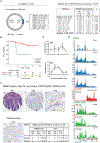Analysis of Several Common APOBEC-type Mutations in Bladder Tumors Suggests Links to Viral Infection
- PMID: 37477495
- PMCID: PMC10592262
- DOI: 10.1158/1940-6207.CAPR-23-0112
Analysis of Several Common APOBEC-type Mutations in Bladder Tumors Suggests Links to Viral Infection
Abstract
FGFR3 and PIK3CA are among the most frequently mutated genes in bladder tumors. We hypothesized that recurrent mutations in these genes might be caused by common carcinogenic exposures such as smoking and other factors. We analyzed 2,816 bladder tumors with available data on FGFR3 and/or PIK3CA mutations, focusing on the most recurrent mutations detected in ≥10% of tumors. Compared to tumors with other FGFR3/PIK3CA mutations, FGFR3-Y375C was more common in tumors from smokers than never-smokers (P = 0.009), while several APOBEC-type driver mutations were enriched in never-smokers: FGFR3-S249C (P = 0.013) and PIK3CA-E542K/PIK3CA-E545K (P = 0.009). To explore possible causes of these APOBEC-type mutations, we analyzed RNA sequencing (RNA-seq) data from 798 bladder tumors and detected several viruses, with BK polyomavirus (BKPyV) being the most common. We then performed IHC staining for polyomavirus (PyV) Large T-antigen (LTAg) in an independent set of 211 bladder tumors. Overall, by RNA-seq or IHC-LTAg, we detected PyV in 26 out of 1,010 bladder tumors with significantly higher detection (P = 4.4 × 10-5), 25 of 554 (4.5%) in non-muscle-invasive bladder cancers (NMIBC) versus 1 of 456 (0.2%) of muscle-invasive bladder cancers (MIBC). In the NMIBC subset, the FGFR3/PIK3CA APOBEC-type driver mutations were detected in 94.7% (18/19) of PyV-positive versus 68.3% (259/379) of PyV-negative tumors (P = 0.011). BKPyV tumor positivity in the NMIBC subset with FGFR3- or PIK3CA-mutated tumors was also associated with a higher risk of progression to MIBC (P = 0.019). In conclusion, our results support smoking and BKPyV infection as risk factors contributing to bladder tumorigenesis in the general patient population through distinct molecular mechanisms.
Prevention relevance: Tobacco smoking likely causes one of the most common mutations in bladder tumors (FGFR3-Y375C), while viral infections might contribute to three others (FGFR3-S249C, PIK3CA-E542K, and PIK3CA-E545K). Understanding the causes of these mutations may lead to new prevention and treatment strategies, such as viral screening and vaccination.
©2023 American Association for Cancer Research.
Conflict of interest statement
CBB is an inventor on patents issued to NCI and receives licensing royalties for BKPyV vaccine technologies. LD has sponsored research agreements with C2i Genomics, Photocure, Natera, AstraZeneca and Ferring, has advisory/consulting roles at Ferring, UroGEN, and has received speaker/video honoraria from Roche, Pfizer and Astellas. Other authors have no conflicts of interest to report in relation to this work.
Figures

References
-
- IARC. [cited 2021 Mar 20]. Available from: <https://gco.iarc.fr/today/online-analysis-table>.
-
- Cancer Statistics Center. [cited 2023 Mar 11]. Available from:. <https://cancerstatisticscenter.cancer.org/>.
Publication types
MeSH terms
Substances
Grants and funding
LinkOut - more resources
Full Text Sources
Medical
Miscellaneous

